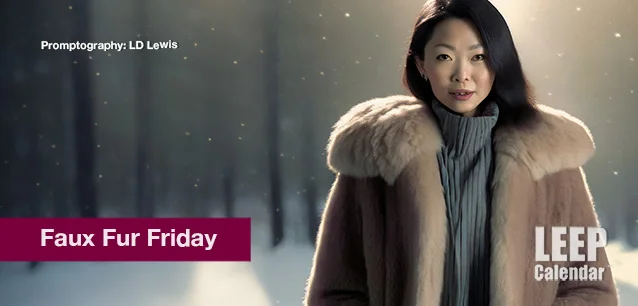 AD
AD
Today is: November 06
Scroll to explore events active on this date.
LEEP INK FEATURES

August? Absolutely!
In August, we live through the Dog Days of Summer. It's hot and often humid, and those who can leave for better climates do. Down south, winter is in full force. August is also known as "the ...

In The Heat of July: July 2025 Events
Is it hot enough (or cold enough if you're below the equator) for you yet? There is actually a day for that! Like every month, I pick a diverse collection of events you may or may not know about. This ...

May Blooms: Events in May 2025
Along with October, May is one of the most densely packed months of the year. It's before the summer humidity and the last whole month of the school year. The weather is warming in t...
About Faux Fur Friday
DESCRIPTION:
Faux Fur Friday, on the first Friday of December, encourages using fake fur in fashion as an alternative to real animal fur. It is likely an add-on event created to augment the sponsored Fur Free Friday a week prior. Faux Fur Friday is an unofficial event with no sponsor.
The history of fur in human clothing dates back to ancient times, primarily driven by the need for warmth. In various cultures, real fur was a status and power symbol reserved for the elite, like ancient Egyptian royalty and European nobility. The use of fur as a luxury item continued for centuries.
Fake fur emerged in the 1800s, initially suggested for children's clothing. By the 1900s, fake fur, or imitation fur, began to gain popularity. Originally made from the wool of unborn or newborn lambs and later mixed with synthetic fibers, faux fur became increasingly affordable and popular by the 1950s, with companies vying to create luxurious synthetic versions.
The anti-fur movement, which gained momentum in the 1970s, further boosted the fake fur industry. Notable events in this movement include the Endangered Species Act of 1973, which aligned with anti-fur protests, and PETA's influential "Rather Go Naked Than Wear Fur" campaign in the 1990s, featuring supermodels like Naomi Campbell and Cindy Crawford. This period saw a significant shift in the fashion industry's attitude toward fur, with more brands and designers exploring cheaper faux fur options.
Today, faux fur is widely used in the garment and home fashion industry. It represents a fashion choice for some, affordability for others, and a stance on animal rights and veganism. However, due to its synthetic construction and disposable fast fashion inclusion, most faux fur is neither sustainable nor environmentally friendly.
VIDEOS
SUPPORTING DOCUMENTS
Currently, this event does not have supporting documents.
ADDITIONAL IMAGES
Currently, this event does not have supporting images.
Where would you like to go now?
 AD
AD


/footer-logo.svg)
